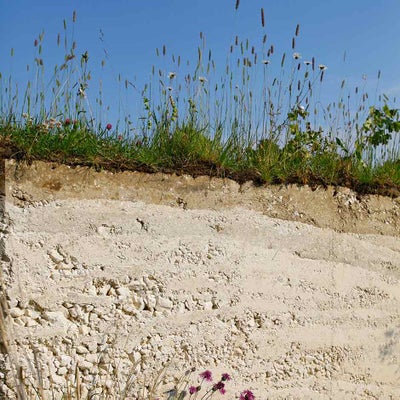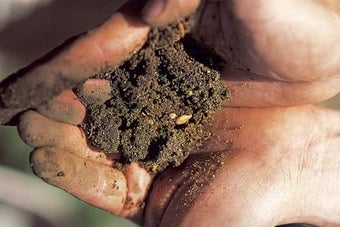
Quick facts
Top 5 plants for chalk:
Ceanothus
Campanula
Clematis
Dianthus
Geranium
Lavandula
Introduction
Many chalky soils are shallow, very free-draining and low in fertility, but variations exist. Where there is clay present, nutrient levels may be higher and the water holding capacity greater.
Where chalky soils are deep, they can be moisture-retentive and support a wide range of plants. They will not support ericaceous plants such as camellia and rhododendrons that need conditions. Very chalky soils may contain lumps of visible chalky white stone. Such soils cannot be acidified, and it is better to choose plants that will thrive in alkaline conditions.
When planting on chalky soils it is important to first establish how deep the topsoil is. Many trees and shrubs that will tolerate conditions may become chlorotic (yellow) on shallow soils over chalks. In some gardens the soil layer may be very thin indeed – only a few inches – before hitting solid chalk. Where this is the case, topsoil will need to be brought in to make planting possible. On shallow soils over chalk where increasing soil depth is not an option, wildflower mixes selected for chalk tolerance may still thrive.
Practical considerations
When planting on chalky soils;
- Break up the chalk to a depth of 75cm (30in) so that plant roots can spread out and establish
- Whether bringing in new soil or improving existing soil, add plenty of well-rotted organic matter such as garden , composted or farmyard manure
- Smaller plants get established more quickly than more mature specimens
- plants with organic matter to conserve moisture
- Attention to watering will be required for a longer period than with other soil types as plants on chalky soils may take several seasons to establish and are more prone to drying
Suitable plants
(+) Best grown on deep and moisture retentive soils over chalk
(gc) Ground cover plants
(v) foliage
(e) evergreen foliage
AGM - The RHS Award of Garden Merit
Many popular species and cultivars are listed below. If you would prefer to view a full list of suitable plants for chalky and alkaline soils, try the RHS Find a Plant.
Trees
Acer campestre: to GB. A. negundo, A. platanoides, A. pseudoplatanus
Aesculus × carnea, A. hippocastanum (horse chestnut), A. indica
Arbutus unedo(+)(e): Native to Ireland
Carpinus betulus (common hornbeam): Native to GB and Ireland
Ceanothusarboreus 'Trewithen Blue' AGM (e)
Cercis siliquastrum
Corylus avellanacultivars, C. avellana 'Contorta' AGM: Cultivars of native to GB and Ireland
C. colurna AGM, C. maximacultivars
Crataegus laevigata (hawthorn): Native to GB and Ireland
Euonymus europaeus (spindle): Native to GB and Ireland
Fagus sylvatica (common beech): Native to GB and Ireland
Fraxinusexcelsior, F. ornus(ash)
Ligustrum lucidumAGM (e)
Malus (apple, crab apple): Native to GB and Ireland
Morus nigra (black mulberry)
Prunus (flowering cherries)
Prunus padus: Native to GB and Ireland
Prunus spinosa: Native to GB and Ireland
Pyrus (common pear and ornamental) (+)
Quercus robur (common oak): Native to GB and Ireland
Sorbus aria (whitebeam): Native to GB and Ireland S. intermedia: Native to GB
Conifers
Cedrus including C. atlantica (Atlas cedar), C. deodara AGM (Deodar cedar), C. libani AGM (Cedar of Lebanon) (e)
Chamaecyparis(+) (e)
Ginkgobiloba (+)
Juniperus communis: Native to GB and Ireland and J. × pfitzeriana (e)
Larix decidua, L. kaempferi (+)
Pinus mugo and P. nigra (e)
Taxus baccata (yew) (e): Native to GB and Ireland
Thuja occidentalis (White cedar) , T. plicata (Western red cedar) (e)
Thujopsis dolobrata (e)
Shrubs
Aucuba japonica (e)
Berberis
Brachyglottis DunedinGroup 'Drysdale', B. Dunedin Group 'Sunshine'AGM, B. monroi,
B Walberton'sSilverDormouse = 'Walbrach'AGM (e)
Buddleja davidiicultivars, B. fallowiana var. alba AGM, B. globosa AGM, B. lindleyana, B. × weyeriana
Caraganaarborescens
CeanothusincludingC. 'Autumnal Blue'AGM, C. 'Dark Star'AGM, C. 'Concha'AGM,
C. 'Pershore Zanzibar' (v),C. 'Puget Blue' AGM, C. thrysiflorus var. repens AGM(e)
Ceratostigma including C. willmottianum Forest Blue = 'Lice' AGM, C. plumbagnoides (gc)
CistusincludingC. × argenteus 'Peggy Sammons', C. creticus, C. × dansereaui 'Decumbens' AGM,
C. laurifolius, C. monspeliensis, C. × pulverulentus 'Sunset' AGM, C. × purpureus (e)
Choisya × dewitteana 'Aztec Pearl' AGM, C. ternataAGM, C. ternata Sundance = 'Lich' AGM
Coluteaarborescens
Cornus sanguinea 'Anny's Winter Orange' AGM: of native to GB and Ireland
Cornus 'Midwinter Fire': Cultivar of native to GB and Ireland
Cytisus
Cornus mas
Cotoneaster
Deutzia
Dipelta floribunda AGM, D. ventricosa
Elaeagnus angustifolia, E. commutata, E. 'Quicksilver'
Euonymus europaeus 'Red Cascade' AGM: Cultivar of native to GB and Ireland
Euonymus fortunei cultivars (gc), E. japonicus cultivars (e)
Forsythia 'Fiesta' (v), F. × intermedia 'Lynwood Variety' AGM, F. suspensa
Fuchsia
Genista lydia
Genista pilosa 'Procumbens' AGM: Cultivar of native to GB and Ireland
× Halimiocistus sahucii AGM (gc), × H. wintonensis 'Merrist Wood Cream' AGM (e)
Halimiumcalycinum, H. lasianthum, H. 'Susan' AGM (e)
Hibiscus syriacus,H. sinosyriacus
Hypericum
Laurus nobilis (+) (e)
Lavandula (e)
Ligustrum japoniucm, L. ovalifolium, L. quihoui (e)
Lonicera nitida, L. pileata (e)
Mahonia aquifolium, M. × media (+) (e)
Olearia (e)
Paeonia delavayi
Potentilla fruticosa: Cultivar of native to GB and Ireland
Pyracantha including P. coccinea 'Red Column', P. 'Orange Glow' AGM, P. 'Teton' AGM (e)
Rhusglabra,R. typhina 'Dissecta' AGM (+)
Ribeslaurifolium, R. odoratum, R. sanguineum 'Pulborough Scarlet', R.speciosum
Romneya coulteriAGM
Rosmarinus officinalis(e)
Rubusbiflorus AGM, R.cockburnianus 'Goldenvale' AGM, R. lineatus, R. spectabilis 'Olympic Double',
R. thibetanus 'Silver Fern'
Sambucus nigra: Native to GB and Ireland, S racemosa 'Sutherland Gold'
Santolina chamaecyparissus, S. pinnata subsp.neapolitana AGM. S. rosmarinifolia (e)
Sarcococca confusa AGM, S. hookeriana var. digyna, S. ruscifolia var. chinensis 'Dragon's Gate'AGM (e)
Spartiumjunceum
Spiraea 'Arguta'AGM, S.japonica 'Anthony Waterer' (v), S. japonica 'Goldflame',
S. japonica Magic Carpet = 'Walbuma'AGM (v), S. nipponica 'Snowmound'AGM
Syringa (lilac)
Tamarixparviflora AGM, T. ramosissima 'Pink Cascade' AGM, T. tetrandra AGM
Teucrium fruticans, T. × lucidrys (e)
Veronica (e)
Viburnum (most)
Viburnum lantana: Native to GB
Viburnum opulus 'Compactum' AGM: Cultivar of native to GB and Ireland
Viburnum opulus 'Xanthocarpum' AGM: Cultivar of native to GB and Ireland
Vincadifformis, V. major,
V. minor (gc) (e): Archaeophyte of GB and Ireland
Vinca minor 'Atropurpurea' AGM
Vinca minor 'Bowles' Variety' AGM
Weigela florida, W. middendorfiana, W. praecox
Yucca filamentosa, Y. flaccida (e)
Climbers and wall shrubs
Actinidia kolomiktaAGM, A.deliciosa (Kiwi fruit)
Akebia × pentaphylla, A. quinata, A. trifoliata
Clematis
Cotoneaster atropurpureus 'Variegatus' AGM, C. horizontalis
Fremontodendron 'California Glory'AGM (e)
Hedera (ivy) (e)
Hedera helix 'Glacier' AGM: Cultivar of native to GB and Ireland
Hedera helix 'Goldchild' AGM: Cultivar of native to GB and Ireland
Jasminum beesianum, J. nudiflorum AGM, J. officinale cultivars (jasmine)
Lonicerapericlymenum (honeysuckle) (+)
Parthenocissus henryana (Chinese Virginia creeper), P. quinquifolia (Virginia creeper),
P. tricuspidata (Boston ivy)
Passiflora caerulea AGM
Solanum crispum 'Glasnevin' AGM, S. laxum 'Album' AGM
Trachelospermum asiaticumAGM, T. jasminoidesAGM (e)
Vitis (ornamental vines)
Herbaceous perennials
Acanthus mollis, A. spinosus
Achillea
Actaea simplex Atropurpurea Group 'Brunette'AGM
Adenophorabulleyana
Agapanthus
Agastache
Alstroemeria
Anchusa azurea 'Lodden Royalist'
Anemone nemerosa: Native to GB and Ireland
Anemone nemerosa 'Robinsoniana' AGM: Cultivar of native to GB and Ireland
Anemone hupehensis, A. × hybrida
Anthemis punctata subsp. cupaniana AGM, A. tinctoria 'E.C. 'Buxton', A. tinctoria 'Sauce Hollandaise'
Aquilegia
Armeria, includingArmeria maritima: Native to GB and Ireland
Artemisiaabsinthium 'Lambrook Silver', A. arborescens AGM, A. lactiflora Guizhou Group
Aster
Astilbe
Ballota pseudodictamnus AGM (e)
Bergenia 'Bressingham Ruby', B. cilliata, B. 'Morgenrote' AGM, B. 'Overture' (e)
Calendula officinalis (Pot marigold)
Campanula glomerata 'Superba' AGM, C. 'Kent Belle' AGM, C. lactiflora 'Pritchards Variety' AGM
Catanachecaerulea 'Major' AGM
Centaurea, including Centaurea scabiosa: Native to GB and Ireland,andC. nigra: Native to GB and Ireland
Centranthus ruber
Cerinthe major 'Purpurascens'
Chelone obliqua
Convallaria majalis (gc)
Coreopsis
Corydalis
Crambe cordifolia AGM
Crocosmia
Cynaracardunculus AGM (cardoon), C. cardunculus Scolymus Group (artichoke)
Cynoglossum
Delphinium
Dianthus, includingDianthus deltoides AGM: Native to GB and Ireland
Dicentra
Digitalis
Doronicum
Echinacea
Echinops
Eremurus
Erigeron
Erodium
Eryngium
Erysimum
Eupatorium
Euphorbia, includingEuphorbia amygdaloides var. robbiaeAGM: Variety of a native to GB
Gaillardia
Galega
Gaura
Gazania
Geranium, including:Geranium sanguineum:Native to GB and Ireland (plus cultivars)andGeranium pratense:Native to GB and Ireland (plus cultivars)
Geum
Helenium
Helianthus
Helleborus, including Helleborus foetidus AGM: Native to GB
Hemerocallis
Heuchera
Hosta
Inula
Iris, including Iris foetidissima AGM: Native to GB
Knautia, Including:Knautia arvensis: Native to GB and Ireland
Kniphofia
Lavatera
Leucanthemum, including Leucanthemum vulgare: Native to GB and Ireland
Liatris
Limonium
Linum, including:Linum perenne: Native to GB
Lobelia
Lychnis - see Silene
Macleaya
Malva including Malva alcea and Malva moschata f. alba
Marrubium
Mimulus
Monarda
Morina
Nepeta
Oenothera
Origanum, includingOriganum vulgare: Native to GB and Ireland (plus cultivars)
Paeonia lactiflora
Papaver
Penstemon
Persicaria
Phlomis
Physalis
Physostegia
Platycodon
Polemonium
Polygonatum
Potentilla, including Potentilla fruticosa:Native to GB and Ireland (plus cultivars)
Pulsatilla, includingPulsatilla vulgarisAGM:Native to GB and Ireland
Pyrethrum
Rudbeckia
Saponaria
Salvia
Scabiosa, including Scabiosa columbaria: Native to GB and Ireland
Sedum
Sidalcea
Silene, IncludingSilene flos-cuculi: Native to GB and Ireland andSilene dioica ‘Rollie’s Favourite’: Cultivar of native to GB and Ireland
Solidago
Thalictrum
Tiarella
Tradescantia
Trollius
Verbascum
Verbena, including Verbena officinalis ‘Bampton’:Cultivar of Archaeophyte to GB and Ireland
Veronica, including: Veronica spicata ‘Rotfuchs’ : Cultivar of Native to GB and Ireland
Viola, including: Viola odorata 'Wellsiana' AGM: Cultivar of Native to GB and Ireland
Zauschneria









